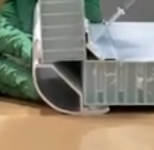rruff
Explorer
It doesn't look ideal... but it seems robust compared to how Styromax does their edges! Although theirs have some overlap so would be better thermally.
Speaking of insulation, the PP honeycomb isn't the best in that department... thinking of the options they list, PVC foam would be the way to go.
Speaking of insulation, the PP honeycomb isn't the best in that department... thinking of the options they list, PVC foam would be the way to go.

